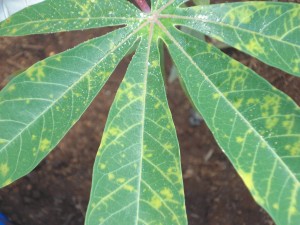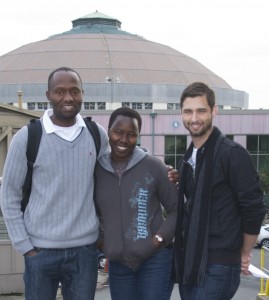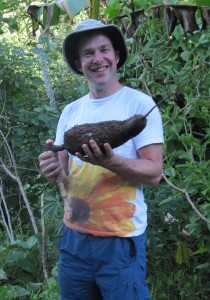What keeps Mtakai Ngara and Teddy Amuge up at night? Thinking about cassava. These young, ambitious, researchers working at the International Institute for Tropical Africa (IITA) just outside Nairobi, Kenya are learning more about genomics to help breed more effective cassava to feed hungry mouths in their native Africa and further afield. To feed their passion for genomics, they made a trip to the DOE JGI and UC Berkeley last November for a two-week study visit.
Cassava (Manihot esculenta), also known as manioc, tapioca or yuca, a herbaceous root tuber, is an important source of calories for 800 million people within the tropics of Africa, Latin America and Asia. Due to its minimal nutrient requirements and flexibility in harvesting times, low-income smallholder farmers in Africa grow cassava. “With certain varieties, farmers can generate decent yields in drought and disease prone regions and infertile soils,” Ngara pointed out, “hence earning it the epithet ‘poor man’s crop.’”
Yield improvement forms the centerpiece of a number of cassava studies at the moment. As a remarkable energy source, improving production will contribute towards meeting immediate food security and potentially future biofuels needs.
Currently, average cassava production is estimated at 15 metric tons per hectare (6.7 U.S. tons per acre), which is six times less than the projected potential of 90 metric tons per hectare) and one of the critical constraints to its yield is disease. “Cassava brown streak disease (CBSD) is caused by a monopartite RNA virus from Potyviridae family,” said Amuge, whose Ph.D. focuses on understanding the virus, which she noted is one of the leading threats to cassava production in Africa.
The existence of cassava varieties that possess tolerance to CBSD provide an invaluable opportunities for establishing resistant varieties through breeding and/or transformation using genomics-based approaches as well as understanding the disease biology and developing high-resolution markers for the trait.
Genetic hybridization between domesticated and wild varieties of cassava has been hypothesized to be responsible for the introduction of genes for CBSD tolerance from the wild relatives into some of the farmer-grown lines. Two wild cassava relatives and tree cassava genomes have been sequenced with the aim of identifying genomic regions that may be involved in this process. This is a research area Ngara would like to develop a Ph.D. thesis on, as he explores options for graduate school.
Albert and Namikonga are two of the established varieties for CBSD susceptibility and tolerance respectively. Based on a low-resolution genetic map, the approximate genomic regions (known as quantitative trait loci or QTLs) underlying CBSD tolerance have been anchored on the reference genome and annotated. A larger (high resolution) mapping population has recently been established with the intent to genotype the markers by sequencing reduced representation of the populations’ genomes. “Understanding CBSD at the molecular level is key to its management,” said Amuge, who is about halfway through her Ph.D. She has set up a time-course RNA sequencing experiment based on CBSD-infected Albert and Namikonga. She hopes this study will unravel the molecular interactions that underpin CBSD, potentially revealing the key to engineering resistant varieties.
In collaboration with a team from the DOE JGI, UC Berkeley and Dow AgroSciences, a total of 15 whole genome sequences have been generated from farmer-grown varieties using Illumina’s paired-end sequencing. “We have identified a whole-genome repertoire of SNPs and INDELs,” said Simon Prochnik, their DOE JGI host. “Genomic resources like these applied to modern breeding methods such marker assisted and genomic selection provide hope for breeding tolerance to CBSD and other diseases as well as important agronomic traits. It’s exciting that Teddy and Mtakai are using their newfound knowledge now that they are back in Africa. And I have a feeling they learned a lot more than we expected on their visit.”
The group will play a critical role in the partnership known as the Next Generation Cassava Breeding project, a five-year, $25.2 million research effort supported by the Bill & Melinda Gates Foundation and the Department for International Development of the United Kingdom, coordinated by Cornell University.
-Written by Mtakai Ngara
Mtakai Ngara is a bioinformaticist working with the cassava genome at the International Institute of Tropical Agriculture.


